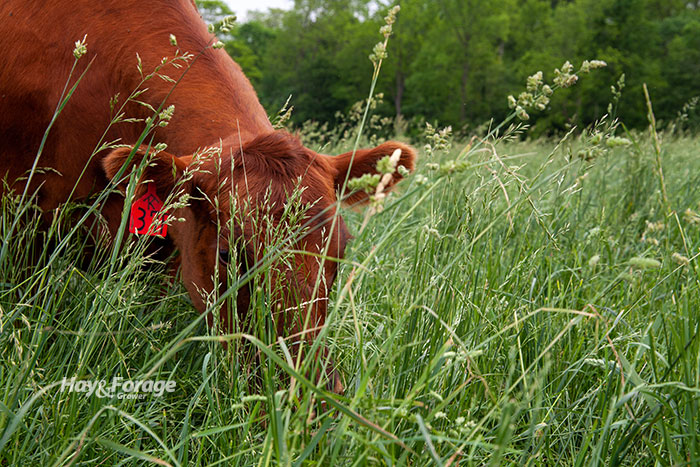
It’s this time of year when grasses show us and tell us what they’re made of. They tell us what they like and what they don’t like. It seems some people never learn the language of grasses while others are obsessed by it.
Although different species of grasses have unique characteristics, as a group they are generally more tolerant of poor management and subpar soils than are many legumes. They often grow in spite of what we do rather than because of what we do.
Although grasses are more forgiving than legumes in terms of where they can grow and what they demand, their range of productivity spans a wide axis based on how we manage them. Over the course of the next four to six weeks, grasses will transition from boom to bust — or lush to flush — if we let them. Of course, it doesn’t have to be this way.
Seedhead sorrow
Virtually all pastures and hayfields look good during this time of year. The ones that don’t are mostly those that were never given a chance to accumulate any growth before animals devoured them.
Unfortunately, the utopian pastures of today in terms of visual appearance and animal productivity are often short lived. Once the seedhead emerges, yield gains come to a grinding halt and bad things start to happen from a forage quality perspective. Further, grass quality doesn’t just gradually decline after seedhead emergence and development; it falls off the cliff.
The neutral detergent fiber (NDF) concentration of grasses is higher than legumes at similar points in maturity. In fact, it’s a lot higher. Mature grasses can approach 70% NDF, while mature legumes may be closer to 50% NDF. However, the percent of NDF that is digestible is much higher in grasses than legumes. That’s the grass advantage that needs to be capitalized on.
Whether grazed or baled, the virtues of grass forage quality can only be realized when utilization occurs before or soon after seedhead emergence. Fiber digestibility declines rapidly once reproductive mode kicks into gear. A high NDF concentration and low NDF digestibility is not a good combination. Effectively, feeding that combination to a cow equates to just making more fiber-laden manure.
In the case of Kentucky 31 tall fescue, seedhead emergence takes on the added disadvantage of higher toxin levels in the inflorescence. This toxicity remains in hay that is baled and fed later.
Finally, many newer grass varieties are bred to head later than older, traditional ones. They’re well worth the investment, especially when paired with alfalfa.
To effectively manage spring grass growth, the University of Kentucky grazing specialists offer these recommendations:
1. Implement rotational grazing. In order to fully utilize the spring flush of pasture growth, you take control of grazing. In a continuous grazing system, the cows are in charge.
2. Start grazing before you think the pastures are ready. A common mistake made by graziers is waiting too long to start grazing in the spring. If you wait until the first paddock is ready to graze, by the time you reach the last paddock, it will be much too mature.
3. Rotate animals rapidly. Match the speed of the rotation with the speed of grass growth. This will allow you to stay ahead of the grass by topping it off and keeping it in a vegetative state.
4. Do not apply spring nitrogen. Applying nitrogen in the spring will actually make the problem of too much grass even worse. In many cases, you are better off to save your nitrogen for early summer or for stockpiling in the fall.
5. Remove the most productive paddocks from rotation and harvest for hay. Graze all paddocks until the pasture growth gets ahead of the cattle. Then, remove those productive paddocks and plan to cut them for hay.
6. Increase stocking density in the spring. If it is possible, a good option for utilizing spring growth is to boost stocking density. This allows you to harvest more of the available forage and convert it into a saleable product. This is often done by adding stockers or thin cull cows to your rotation and then selling them when pasture growth slows.
7. Even out seasonal distribution of forage by adding a warm-season grass. Adding a well-adapted warm-season grass that produces the majority of its growth in July and August would allow you to increase your season-long stocking density to better utilize the spring flush of pasture growth.
8. Clip or mow out of control pastures. The benefits of clipping include maintaining pastures in a vegetative state, encouraging regrowth, and controlling weeds. Clipping pastures costs money, so make sure that the primary reason for clipping is pasture management, not aesthetics.

